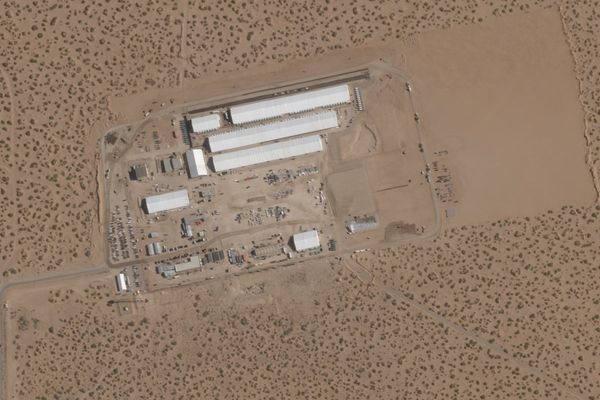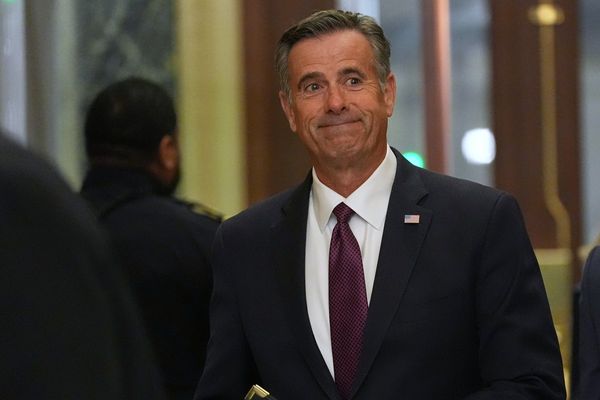
This one-off documentary is brought to you by the production company that made Europe from Above, Hidden Britain by Drone, and The Emirates from Above. It specialises in using aerial photography to find new perspectives, in other words – but Ukraine from Above: Secrets from the Frontline (Channel 4) is not like the others.
Almost a year since the Russian invasion of Ukraine, pictures taken from the air illustrate a story of destruction on a hideous scale. Before and after photographs show Ukrainian apartment blocks that used to teem with happy everyday life, now with every window blown out; previously magnificent theatres with craters in the roof; and pictures of whole cities which, when overlaid on a map, show the systematic razing of civilian buildings such as schools and health centres. Modern drone technology enables those images to be taken closeup, a development that has turned this theatre of war into a heavily surveilled crucible where atrocities are hard to conceal. When the Russians massacred surrendering civilians on the road out of Kyiv, a drone was in the air above them, clearly filming a man with his hands raised being shot dead.
A documentary rounding up such images would be fine and worthy, but Ukraine from Above is not just about the filth of conflict, as captured by drone cameras. It concerns a kind of asymmetric warfare in which the drone camera is a weapon. We see how – at least in the early phases of the invasion, before much heavyweight western hardware had made it across the border – the mighty Russian conquest machine was repeatedly banjaxed by hobbyists using kit you could’ve bought in the Kharkiv branch of Currys.
Ukraine’s drone resistance began at the start of the incursion, when Russian airborne troops landed on Antonov airport near Kyiv. When supply trucks and armoured vehicles arrived, what would become a familiar pattern fell into place. Drone operators reported the exact coordinates of key assets to Ukrainian artillery batteries, which could now fire with much improved accuracy. The airport was no longer a safe place from which to launch an assault.
Those drone operators included the likes of Andrii Pokrasa, who, in a documentary that interviews resistance leaders and sergeant majors, is captioned simply as “schoolboy” and looks no older than 14. When the Russians mobilised a column of tanks to the south-east of Kyiv and headed for the city, what they didn’t know was that Andrii and his dad were hiding in a hedge 600 metres away, Andrii expertly tweaking the controls of his drone like a gamer. Andrii’s piloting provided the intel, his dad alerted the local resistance leader and, again, artillery fire did the rest. “They did not go to Kyiv that day,” says Andrii’s father, drily.
Ukraine from Above’s sections on civilian drone warfare produce startling footage and extraordinary characters. We meet two brothers who use a 3D printer to make little holsters for drones. These gizmos can hold a single grenade and include a mechanism to release it. We see video of Russian soldiers gathered in small groups, awaiting orders – what they don’t know is that a grenade, dropped from a drone hovering above them that was modified by two blokes in a small workshop, is silently falling towards their heads, with the drone additionally recording their deaths for posterity and propaganda. Ukraine from Above also has pictures of tanks, or at least the people in them, obliterated thanks to the homemade grenade-drone’s ability to drop an explosive through the 2ft hatch on the top of the turret. “With a drone worth about $2,500 and a release mechanism worth $50,” says one of the device’s creators, with a bracing matter-of-factness, “we can destroy equipment worth several million.”
Eventually the programme runs out of astonishing stories specifically related to drones, although another unsettling highlight is an interview with Andriy Khlyvnyuk, once the singer in rock band BoomBox (he also collaborated with Pink Floyd on a protest song) but now a pilot of “Punisher” drone bombers. Evidently BoomBox used to be big in Russia: “I am eliminating my own audience,” Khlyvnyuk says, with the same mix of sadness and determination as the farmer whose land was flooded when a dam was destroyed to stop a Russian advance, or the mother and daughter from Mariupol who survived it being mercilessly bombed and are now safe in Vilnius, but wish they were back at home.
Those tales don’t really need any aerial technology to be told. They do, however, emphasise how high the stakes are in a war that has to be seen from every angle to be believed.







